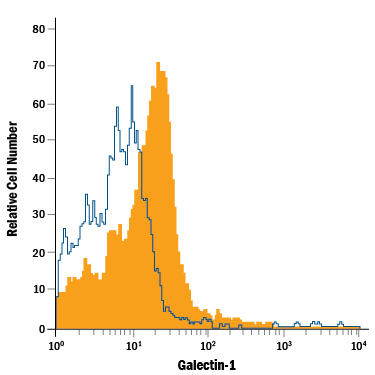Mouse Galectin-1 PE-conjugated Antibody Summary
Ala2-Glu135
Accession # P16045
Applications
Please Note: Optimal dilutions should be determined by each laboratory for each application. General Protocols are available in the Technical Information section on our website.
Scientific Data
 View Larger
View Larger
Detection of Galectin‑1 in Mouse Splenocytes by Flow Cytometry. Mouse splenocytes were stained with Goat Anti-Mouse Galectin-1 PE-conjugated Antigen Affinity-purified Polyclonal Antibody (Catalog # IC1245P, filled histogram) or isotype control antibody (Catalog # IC108P, open histogram). To facilitate intracellular staining, cells were fixed with Flow Cytometry Fixation Buffer (Catalog # FC004) and permeabilized with Flow Cytometry Permeabilization/Wash Buffer I (Catalog # FC005). View our protocol for Staining Intracellular Molecules.
Reconstitution Calculator
Preparation and Storage
- 12 months from date of receipt, 2 to 8 °C as supplied.
Background: Galectin-1
The galectins constitute a large family of carbohydrate-binding proteins with specificity for N-acetyl-lactosamine-containing glycoproteins. At least 14 mammalian galectins, which share structural similarities in their carbohydrate recognition domains (CRD), have been identified to date. Galectin-1 has been classified as a prototype galectin (-1, -2, -5, -7, -10, -11, -13, -14), which contains one CRD and exists either as a monomer or a noncovalent homodimer. The chimera galectins (such as Galectin-3) contain one CRD linked to a nonlectin domain, while the tandem-repeat galectins (-4, -6, -8, -9, -12) consist of two CRDs joined by a linker peptide. Galectins lack a classical signal peptide and can be localized to the cytosolic compartments where they have intracellular functions. However, via one or more as yet unidentified non-classical secretory pathways, galectins can also be secreted and function extracellularly. Individual members of the galectin family have different tissue distribution profiles and exhibit subtle differences in their carbohydrate-binding specificities. Each family member may preferentially bind to a unique subset of cell-surface glycoproteins (1-5).
Mouse Galectin-1, also known as beta-galactoside-binding lectin L-14-I, lactose-binding lectin 1, S-Lac lectin 1, galaptin and 14 kDa lectin, is a monomeric or homodimeric prototype galectin that is expressed in a variety of tissues and cells including muscle, heart, lymph nodes, spleen, thymus, macrophages, B cells, T cells, dendritic cells, and tumor cells. It preferentially binds laminin, fibronectin, 90K/Mac-2BP, CD45, CD43, CD7, CD2, CD3, and ganglioside GM1. Galectin-1 modulates cell growth, proliferation and differentiation, either positively or negatively, depending on the cell type and activation status. It controls cell survival by inducing apoptosis of activated T cells and immature thymocytes. It modulates cytokine secretion by inducing Th2 type cytokines and inhibiting pro-inflammatory cytokine production. Galectin-1 can also modulate cell-cell as well as cell-matrix interactions, and depending on the cell type and developmental stage, promote cell attachment or detachment. Galectin-1 has immunosuppressive and anti-inflammatory properties, and has been shown to suppress acute and chronic inflammation and autoimmunity. Mouse and human Galectin-1 share about 88% amino acid sequence similarity (1-6).
- Rabinovich, A. et al. (2002) Trends Immunol. 23:313.
- Rabinovich, A. et al. (2002) J. Leukoc. Biol. 71:741.
- Hughes, R.C. (2001) Biochimie 83:667.
- Viquier, M. et al. (2014) Tissue Barriers 2:e29103.
- Compagno, D. et al. (2014) Curr. Mol. Med. 14:630.
- Goldring, K. et al. (2002) J. Cell Sci. 115:355.
Product Datasheets
Citation for Mouse Galectin-1 PE-conjugated Antibody
R&D Systems personnel manually curate a database that contains references using R&D Systems products. The data collected includes not only links to publications in PubMed, but also provides information about sample types, species, and experimental conditions.
1 Citation: Showing 1 - 1
-
Single-cell RNA sequencing reveals evolution of immune landscape during glioblastoma progression
Authors: AT Yeo, S Rawal, B Delcuze, A Christofid, A Atayde, L Strauss, L Balaj, VA Rogers, EJ Uhlmann, H Varma, BS Carter, VA Boussiotis, A Charest
Nature Immunology, 2022-05-27;23(6):971-984.
Species: Mouse
Sample Types: Whole Cells
Applications: Flow Cytometry
FAQs
No product specific FAQs exist for this product, however you may
View all Antibody FAQsReviews for Mouse Galectin-1 PE-conjugated Antibody
There are currently no reviews for this product. Be the first to review Mouse Galectin-1 PE-conjugated Antibody and earn rewards!
Have you used Mouse Galectin-1 PE-conjugated Antibody?
Submit a review and receive an Amazon gift card.
$25/€18/£15/$25CAN/¥75 Yuan/¥2500 Yen for a review with an image
$10/€7/£6/$10 CAD/¥70 Yuan/¥1110 Yen for a review without an image

